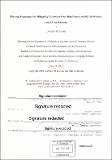| dc.contributor.author | Lorilla, Lorenzo M.,
1981- | en_US |
| dc.contributor.other | Massachusetts Institute of Technology. Department of Electrical Engineering and Computer Science. | en_US |
| dc.date.accessioned | 2005-05-19T15:31:36Z | |
| dc.date.available | 2005-05-19T15:31:36Z | |
| dc.date.copyright | 2003 | en_US |
| dc.date.issued | 2003 | en_US |
| dc.identifier.uri | http://hdl.handle.net/1721.1/16980 | en_US |
| dc.description | This electronic version was submitted by the student author. The certified thesis is available in the Institute Archives and Special Collections. | en_US |
| dc.description | Thesis: M. Eng. and S.B., Massachusetts Institute of Technology, Dept. of Electrical Engineering and Computer Science, 2003 | en_US |
| dc.description | Includes bibliographical references (pages 165-169). | en_US |
| dc.description.abstract | With the increasing popularity and assimilation of wireless devices into the everyday lives of people, the issue of their feasibility for coexisting with other radio frequency (RF) devices arises. Particularly strong interferers for the IEEE 802.11b standard are microwave ovens, since both operate at 2.4 GHz. The interference mitigation techniques all exploit the differences between the interference and the signal, since the former is sinusoidal in nature while the latter can be viewed as noise. The first mitigation filter operates in the frequency domain and filters the received signal's Fast Fourier Transform (FFT) sequence by detecting and removing peak sinusoidal components over the flat 3- dB bandwidth of the signal. The second is a Least Mean Square (LMS) Adaptive filter that produces an estimate of the interference through a recursive approximation method and subtracts it out from the received signal. The third and last is the Adaptive Notch Filter (ANF) which implements a lattice structure and has a time-varying notch frequency parameter that converges to and tracks the frequency of the interference in the received signal. The three filters are shown to produce improvements in the bit error rate (BER) and frame error rate (FER) performance of the receiver under various relative strengths of the signal with respect to the interference. | en_US |
| dc.description.statementofresponsibility | by Lorenzo M. Lorilla. | en_US |
| dc.format.extent | 169 pages | en_US |
| dc.language.iso | eng | en_US |
| dc.publisher | Massachusetts Institute of Technology | en_US |
| dc.rights | MIT theses may be protected by copyright. Please reuse MIT thesis content according to the MIT Libraries Permissions Policy, which is available through the URL provided. | en_US |
| dc.rights.uri | http://dspace.mit.edu/handle/1721.1/7582 | en_US |
| dc.subject | Electrical Engineering and Computer Science. | en_US |
| dc.subject.lcc | TK5105.7 | en_US |
| dc.title | Filtering techniques for mitigating microwave oven interference on 802.11b wireless local area networks | en_US |
| dc.type | Academic theses. | en_US |
| dc.type | Academic theses. | en_US |
| dc.type | Thesis | en_US |
| dc.description.degree | M. Eng. and S.B. | en_US |
| dc.contributor.department | Massachusetts Institute of Technology. Department of Electrical Engineering and Computer Science | en_US |
| dc.identifier.oclc | 53842266 | en_US |
| dc.description.collection | M. Eng. and S.B. Massachusetts Institute of Technology, Dept. of Electrical Engineering and Computer Science | en_US |
| dspace.imported | 2025-01-23T22:48:46Z | en_US |
